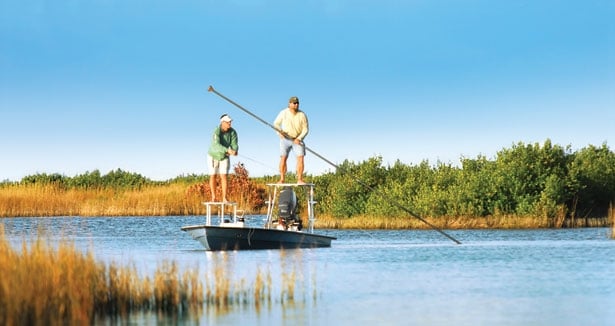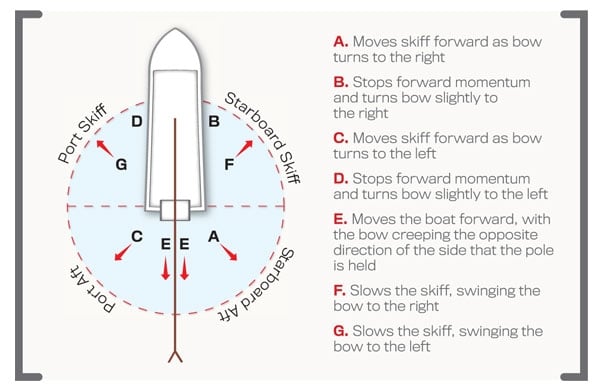
It’s a safe assumption that the art of poling a fishing skiff as we know it today was developed and perfected in the Florida Keys and Everglades.
And to say the least, we have come a long way since the days Capt. Jimmy Furlong pushed from atop a tall center console constructed near the back of the skiff or when Capt. Flip Pallot balanced himself atop a Mercury outboard cowling while holding a fiberglass pole-vaulting pole. Heck, just look how far we have come since the late ’60s, when Capt. Bill Curtis urged Bob Hewes to include a poling platform on what is now considered the first modern flats skiff. Much has changed in the years since. Today we are using boats and push poles made from space-age materials and with state-of-the-art manufacturing processes. The only thing that has not changed is how we use them.
**Have You Got Contact?
**Where the pole makes contact with bottom means everything when you’re trying to control a skiff, and control is exactly what poling is all about. It doesn’t matter how hard a person pushes, if the foot placement is not correct, control is lost.
To better understand, you have to imagine four quadrants that extend out about two-thirds the length of the push pole, with the poling platform being at the center. It’s important to know how poling in each one of these quadrants affects the movement and positioning of the skiff. We will label the quadrants as follows: port skiff, starboard skiff, port aft and starboard aft.
Now one of the first and most important things to know about poling a skiff is that the pole should always be on the downwind or down-current side of the boat (whichever has the greatest influence on the skiff). For example, if you are poling along in a crosswind, with the wind blowing at you from the left, the pole should be on the right of your body. If you hold the pole there and push from directly astern, the bow will want to turn ever so slightly into the influence, hence giving you better control. This of course also applies when poling diagonally into wind or downwind.
**Quadrant Theory
**Moving on, it is time to understand how the quadrants I mentioned earlier come into play. To make things easier to understand, we will assume that there is little to no wind or current. You will want to push or apply pressure on the side of the boat that is the direction in which you want the bow to turn. So let’s say you are sitting dead in the water and would like to move forward while turning to the left. You would place the pole in the port aft quadrant and push, causing the boat to move forward and the bow to start turning. How dramatic the turn will be is determined by how far from the centerline of the skiff the pole is placed.
Now let’s assume you are moving at a good clip straight downwind, see a fish at the 12 o’clock position and need to turn the boat to give your right-handed caster a shot. It is not only important to turn the boat, but it’s every bit as important to slow or stop the boat so that you don’t approach the fish too quickly. This is when you should move the foot of the push pole forward into the starboard skiff quadrant, making contact with the bottom. Rather than pushing off, apply pressure and hold. This will arrest the forward momentum, causing the bow of the skiff to turn to the right, or to more accurately describe it, the stern of the boat to slide to the left, thus putting the fish at the 10 o’clock position.
**Pole Position
**The most difficult concept to grasp when it comes to poling a skiff is where in the quadrant the foot should strike. Well, a good rule of thumb is the closer the pressure or push is applied to the center (the poling platform), the less effect it will have. An exception to this rule is when the need arises to overcome a strong head wind or current to make the skiff move forward. In this situation, you must make a long, powerful push forward, starting close, but not too close, to the platform. Remember, you are trying to propel the boat forward, and if the foot is too close to the transom, the push pole will be close to vertical and you will be wasting energy by pushing down rather than out.
Here’s another way to look at where to place the pole when you want to slow down dramatically or stop. The faster the boat is moving, the farther away from the poling platform the pressure should be applied and held. And if you want to move at a quicker pace or turn faster, the longer the stroke should be and the farther away the end of the push should occur.
As for moving in a straight line, I again emphasize keeping the pole on the side opposite of the most influence (whether that’s wind or current) and pushing close to the centerline, making as small of corrections in foot placement as possible. The biggest mistakes are made by overcorrecting. Only with practice will an angler learn all of the subtleties of the art of poling a skiff.

Take a look at the diagram below to see what should occur when a pole is placed in the different quadrants and a push or hold is applied. This diagram is nothing more than a guideline to get you started and far from describes every scenario encountered while atop the platform, especially in regard to strong winds and current.
I prefer to use as light of a push pole as possible and outfit it with a true fork that I designed myself. A lighter push pole reduces the fatigue factor, making it less likely that I’ll lazily drag or splash the foot around when taking it in and out of the water. As for the fork, the lack of what has been called a “mud bar” or “crotch” allows it to exit and re-enter the water more quietly and without cavitation, and it is less likely to get clogged with mud.
When poling, keep the pole at as low an angle as possible. If the pole is closer to straight up and down, you will be pushing downward and effectively doing nothing. Also, if you keep the pole lower, fish are less likely to see it moving against the sky.









